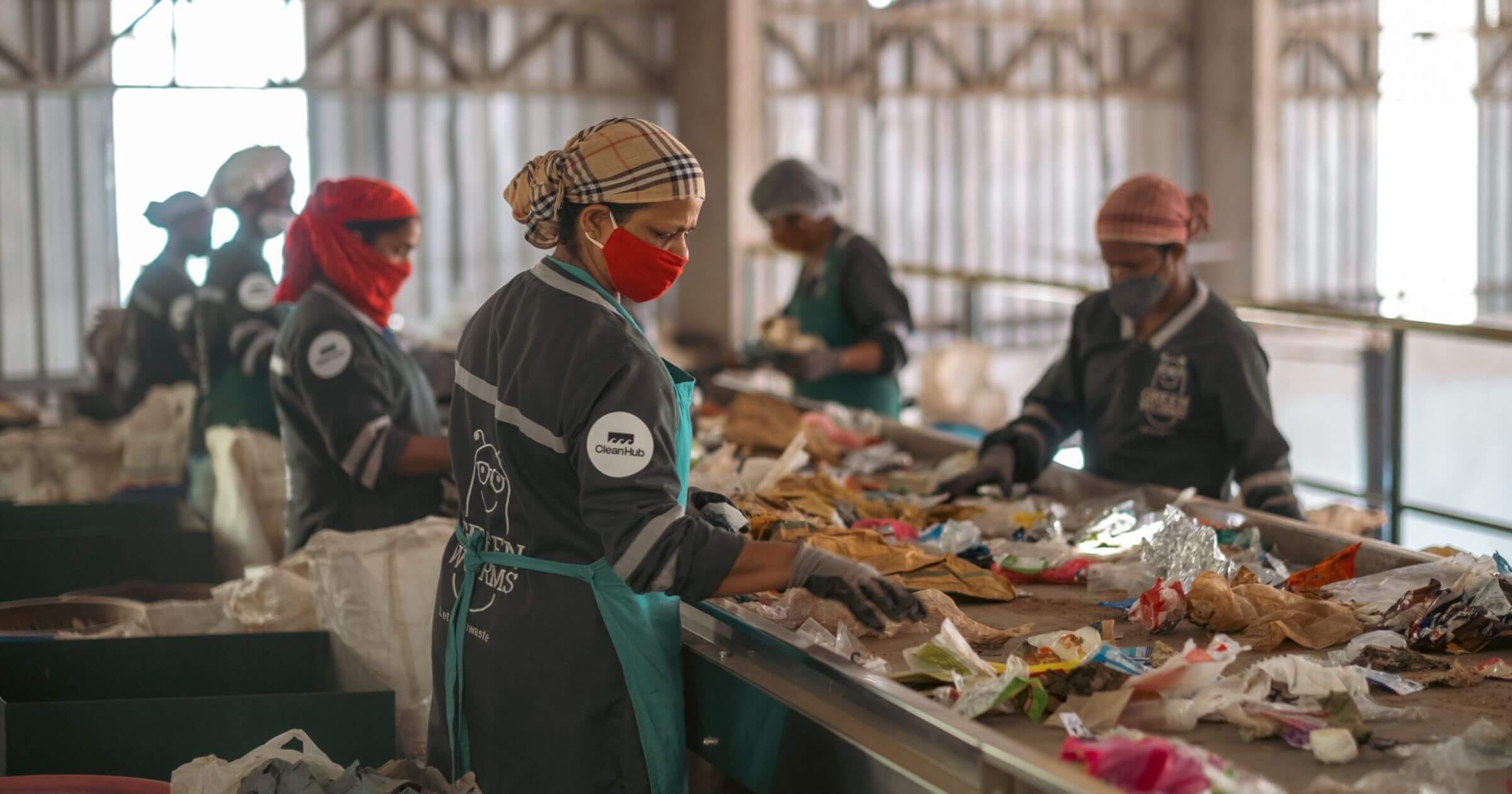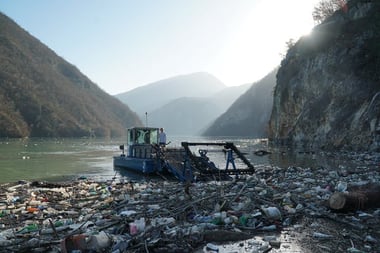
Beth Howell
Beth has been writing about the environment and climate change for over four years now – with her work being featured in publications such as The BBC, Forbes, The Express, Greenpeace, and in multiple academic journals.
At CleanHub, we’re on a mission to build a solution to plastic pollution, by stopping at source. We do this partnering with brands that help us fund door-to-door and community waste collection in parts of the world that are most vulnerable to plastic pollution.
So far, we’ve collected over 18,000,000 kilograms (kg) of plastic — and we plan on collecting a lot more in the coming years.
Achieving this goal partly comes down to our range of collection techniques. That’s why we’re here to show you exactly how we go about collecting plastic waste, and why we choose these methods. Read on to find out everything you need to know.
What’s on this page?
01 | Our impact02 | How we collect plastic waste
03 | Understanding the plastic pollution crisis
04 | Summary
05 | FAQs
Our impact
At CleanHub, we want a world free of plastic pollution — and we’re making this happen by collecting all kinds of waste from coastal communities, preventing it from being openly burnt, dumped, and reaching waterways.
So, how much waste have we collected so far? Let’s break it down.
As of May 2024, we’ve collected 9,529,203 kilograms (kg) of waste — all financed by our amazing brand partners. That’s the same weight as 317 humpback whales!
This is mainly made up of plastics but also contains paper, cardboard, and wet waste. Our collection hubs estimate that roughly 30% of the waste we collect and sort is recyclable plastic, which is then sold into the recycling process.
To make sure our projects have additionality — meaning they wouldn’t have happened without our financial support — we only incentivize and pay for non-recyclable waste. So far, we’ve collected 5,077,792 kg of non-recyclable certified waste, measured as ‘net-dry’ plastic waste where the moisture contents are deducted from the final weight.
On top of this, one of our key goals is to bring more transparency to the waste industry, which is why we also partner with waste managers beyond plastic credits, inviting them to use our technology to track collections and manage their operations.
Through this partnership, an additional 343,875 kg of waste has been tracked using CleanHub’s technology, including mixed municipal solid waste or pre-sorted waste.
How we collect plastic waste
There’s no silver bullet when it comes to plastic waste collection. Although the majority of our plastic recovery efforts come from household collection, we also explore other smart methods.
Here are some of the most common ways we collect plastic waste, and prevent a buildup in the ocean.
1. Collecting household waste
The best way to prevent ocean pollution is by addressing the root cause — that’s why we focus most of our work on household waste collection.
Some of our projects in Indonesia also go one step further by carrying out door-to-door collection.
There are three key reasons why this is the most effective method when it comes to reducing plastic waste in the long term: it addresses the root cause of the problem, it’s extremely efficient for plastic recovery, and it connects communities to waste management systems.
Let’s explore this in a little more detail.
It addresses the root cause
Plastic isn’t usually discarded in the ocean — it’s typically littered on land or riverbeds. This waste then travels to nearby waterways, or further downriver, eventually ending up in the ocean.
This is the primary reason why we collect waste from households; we prevent plastic from actually reaching the ocean in the first place.
It’s efficient in plastic recovery
Another key reason why we choose household collection is because it’s far more efficient than litter picking.
We primarily focus our efforts on non-recyclable plastic items — such as empty chip bags, candy wrappers, and plastic bags — which each have an average weight of between 1-8 grams (g).
It connects communities to a waste management system
Many of us take our waste management systems for granted, but not everyone is lucky enough to benefit from household waste collectors.
Some communities only have two main options: to burn their waste or discard it in the open environment.
This is why we believe household waste collection is the best way to reduce plastic pollution in the long term. After all, we can only really solve the plastic pollution crisis if everyone in the world has access to a waste management system.
2. Utilizing existing systems
Most European countries have access to recycling centers that deal with recyclable materials, electronic waste, or old furniture and mattresses.
These places also exist in developing countries — on a smaller scale, but in much higher numbers — and are sometimes known as “waste banks” (though the name changes slightly depending on the nation).
Traditionally, waste banks in developing countries only accept recyclable goods. However, at CleanHub, we’re utilizing these facilities as aggregation points for non-recyclable waste. This has been made possible through our incredible waste management partners:
- ecoBali – based in Indonesia
- GOT BAG – based in Indonesia
- Green Worms – based in India
- Recity – based in India
- No Trash Triangle Initiative – based in Indonesia
- vRecycle – based in India
- COMPED – based in Cambodia
- The Recycler – based in Tanzania
This setup means citizens can now benefit from a waste management system that takes non-recyclable waste as well as recyclable items. It’s a win for both the environment and the locals.
3. Empowering micro-entrepreneurs
In many developing countries, some people already go from house to house collecting recyclable goods as a way to make money. Once they’ve collected the waste, they’ll sell it on to organizations through small scrap shops.
As part of our recovery efforts, we also work with people at scrap shops to source non-recyclable plastic waste and make sure it’s dealt with responsibly.
4. Running beach cleanups
Together with our collection partners, we organize and sponsor regular beach cleanups in areas vulnerable to plastic pollution.
Cleanups tend to receive criticism from the waste management industry, with the main complaint being that they’re not an effective tool for solving the root problem.
Although this statement is true, solving the plastic pollution crisis will need efforts from all angles. While household collection tackles the root cause of plastic pollution and prevents it from continuing, beach cleanups can focus on improving the huge swathes of land that are currently smothered in plastic.
Beach cleanups also have an immediate impact on wildlife. Changing tides are constantly flushing new plastic onshore — but collecting these washed-up items will prevent them from returning to the ocean and potentially harming marine life.
Picking up waste on beaches also educates others, raises questions from beach visitors, and encourages people to lead by example.
Check out this footage of our recent beach clean-ups with our collection partners:
5. Invest in collection technology in rivers
As well as cleaning up coastal areas, we help keep rivers plastic-free — preventing items from drifting downstream and into the ocean.
We do this by partnering with selected organizations that install barriers in rivers. This is effective because the waste tends to accumulate at one specific point due to the currents, which means there’s very little effort needed from the people working on the project.
These barriers are also a great visualization of how much plastic actually floats through the rivers.

Understanding the plastic pollution crisis
Rapid growth in global plastic production didn’t happen until the 1950s. However, annual plastic production has exploded since then, increasing by nearly 230-fold to 460 million tonnes.
This excessive production, paired with the fact that some plastics take hundreds of years to degrade, means our planet is now being smothered in the stuff. Plastic has reached every corner of the world — even the deepest part of the ocean: the Mariana Trench.
And given one in four people (2 billion individuals globally) don’t have access to proper waste management systems, this plastic pollution is only set to increase over time.
If there is no waste collection system in place, trash will be left on the streets, dumped into rivers and oceans, or even burned.
The waste management problem in developing countries
Waste management is typically paid from two sources: taxes and extended producer responsibility (a law in some countries that requires brands to pay a small fee for every piece of packaging they sell).
Unfortunately, countries with low GDP typically don’t have enough tax funds to pay for waste management facilities and processes. Put simply, it’s much cheaper to dump waste in a landfill than to set up proper recovery centers.
And the recycling facilities that do currently exist in developing countries are few and far between, meaning they’re often too far away from people who need them. This is a particular challenge for many island communities.
In recent years, some waste has become valuable and can be traded as a commodity. As a result, there is an entire informal sector that organizes itself around collecting, sorting, and recycling raw materials, such as newspapers, cartons, metals, and certain types of plastic.
Although this is a good thing, it amplifies the waste management problem in developing countries. The only type of materials that are seen as valuable in this market are items that can be recycled — that leaves a lot of non-recyclable materials with no place to go but the ocean.
That’s why CleanHub focuses its efforts on collecting this low-value waste that can’t be recycled.
Instead, we send it to an incineration plant that turns the waste into cleaner fuel, which is eventually used to create low-carbon cement. This saves roughly 600 kg of carbon dioxide (CO2) per ton of plastic.
You can learn more about this on our page: What Happens to the Waste We Collect?
Summary
Hopefully, you’re now feeling a bit more clued up on the different ways CleanHub collects plastic around the world.
It isn’t an easy task, but it’s one that we feel passionate about — and we wouldn’t be able to do it without the help of our brand partners.
If you’d like your brand to reduce its plastic footprint and be a part of this exciting project, get in touch with our in-house team using the button below. Once we’ve got a call set up, we can discuss the different ways your brand can support this important cause.
Want to reduce your business’s plastic footprint? We can help. All you have to do is get in touch with our in-house team using the form below. Once we’ve received your details, we can arrange a call to discuss which plastic recovery plan will suit your business needs best.
FAQs
Does CleanHub collect plastic from the oceans?
We only collect a very small amount of plastic from the ocean, which is usually by-catch from local fishermen.
There are organizations that already work on recovering plastic from the ocean, and we tip our hats to them. Although ocean plastic-recovery methods have been questioned by some, we need all hands on deck to tackle the plastic pollution problem.
And while these organizations focus on plastic that’s already in the ocean, we’re dedicated to stopping plastic from reaching the oceans in the first place.
Why only focus on coastal areas?
All of our collection hubs are located near rivers and areas that are roughly 20 to 30 miles from the coast.
The reason we focus on these coastal areas is simple: they tend to be more heavily polluted with plastic than other areas. The waste here mounts up pretty rapidly, and ends up in the oceans through river currents or after heavy rainfall.
Some studies also suggest that waste located up to 50 kilometers from the coast has the highest chance of reaching the ocean. So by focusing our efforts in these regions, we can have a bigger impact than if we were to focus on more inland areas.
Can customers decide where plastic is collected?
Yes, any brands that partner with CleanHub can choose from two options:
- A portfolio of hubs – With this plan, brands can fund the collection of plastic from each of the hubs that we work with. This means they’ll be helping communities in Indonesia, India, Cambodia, and Tanzania. For transparency’s sake, brands will get a detailed report of how much they collect from each area
- A focus on one hub – This option allows brands to dedicate their funds to one specific hub, which means more plastic will be recovered in that community
What is the direct impact of opening a waste collection hub?
Waste collection hubs have a range of direct benefits for both the environment and the local community.
- Environmental benefits – In many developing countries, there are no formal waste management systems without collection hubs. This can only mean one thing: plastic pollution in precious ecosystems. By setting up these facilities, we’re helping wildlife of all shapes and sizes, reducing the chance of microplastics getting embedded in the surrounding land and water, and creating a cleaner living environment for locals
- Social impact – Collection hubs also benefit locals in the nearby communities. Not only do they improve the living conditions, but they also create safe jobs, where workers are treated well for their hard work
Who works for the collection hubs, and how are they hired?
At the collection hubs that we work with, workers are usually based in local communities, with the vast majority being female employees.
Our selected hubs provide locals with access to dignified work with proper health and safety standards in place, as well as health insurance.
The employees are hired by the hubs themselves, as they have more local knowledge about the necessary requirements. However, we carry out a social audit on each hub that we work with, to make sure they provide the working standards and benefits as advised by the labor standards.

.webp)

.webp?width=380&name=Water-bottles%20(1).webp)
.png?width=380&name=CleanHub%20Bcorp%20(1).png)
.webp?width=380&name=Plastic-bales%20(1).webp)
.webp?width=380&name=ESG-meeting%20(1).webp)
.webp?width=380&name=warehouse%20(1).webp)
.webp?width=380&name=Recycling-plant%20(1).webp)

.webp?width=380&name=Beach-clean%20(1).webp)
.webp?width=380&name=Plastic-water-bottles%20(1).webp)
